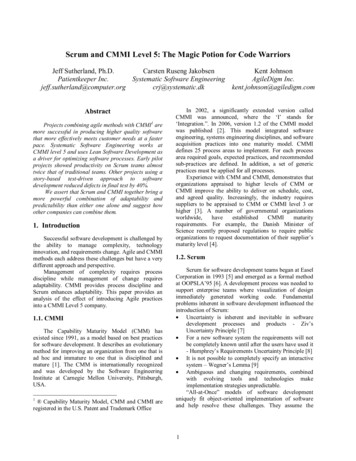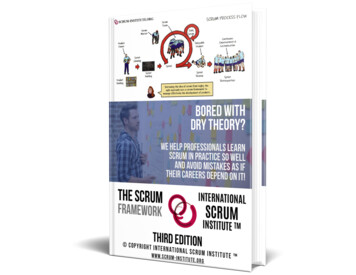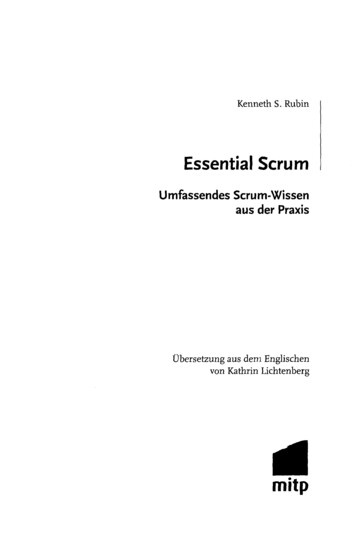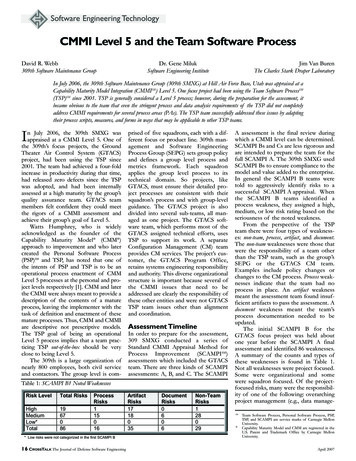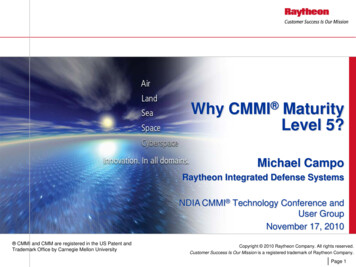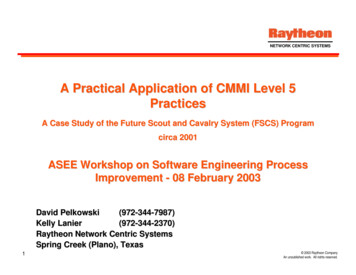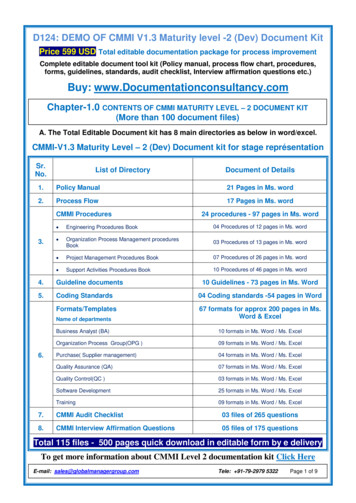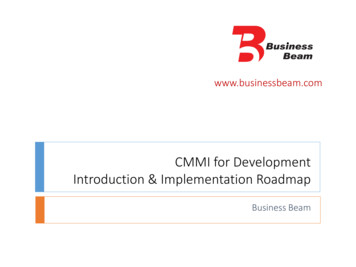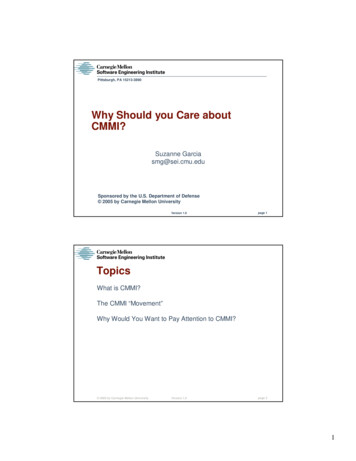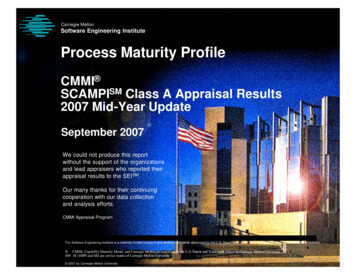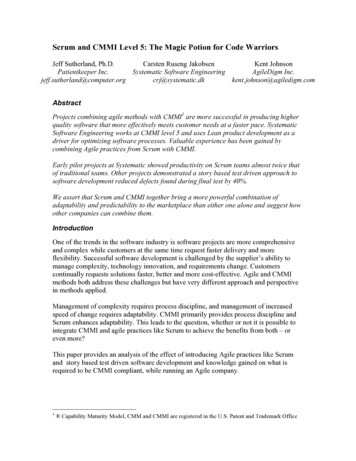
Transcription
Scrum and CMMI Level 5: The Magic Potion for Code WarriorsJeff Sutherland, Ph.D.Carsten Ruseng JakobsenKent JohnsonPatientkeeper Inc.Systematic Software EngineeringAgileDigm ent.johnson@agiledigm.comAbstractProjects combining agile methods with CMMI1 are more successful in producing higherquality software that more effectively meets customer needs at a faster pace. SystematicSoftware Engineering works at CMMI level 5 and uses Lean product development as adriver for optimizing software processes. Valuable experience has been gained bycombining Agile practices from Scrum with CMMI.Early pilot projects at Systematic showed productivity on Scrum teams almost twice thatof traditional teams. Other projects demonstrated a story based test driven approach tosoftware development reduced defects found during final test by 40%.We assert that Scrum and CMMI together bring a more powerful combination ofadaptability and predictability to the marketplace than either one alone and suggest howother companies can combine them.IntroductionOne of the trends in the software industry is software projects are more comprehensiveand complex while customers at the same time request faster delivery and moreflexibility. Successful software development is challenged by the supplier’s ability tomanage complexity, technology innovation, and requirements change. Customerscontinually requests solutions faster, better and more cost-effective. Agile and CMMImethods both address these challenges but have very different approach and perspectivein methods applied.Management of complexity requires process discipline, and management of increasedspeed of change requires adaptability. CMMI primarily provides process discipline andScrum enhances adaptability. This leads to the question, whether or not it is possible tointegrate CMMI and agile practices like Scrum to achieve the benefits from both – oreven more?This paper provides an analysis of the effect of introducing Agile practices like Scrumand story based test driven software development and knowledge gained on what isrequired to be CMMI compliant, while running an Agile company.1 Capability Maturity Model, CMM and CMMI are registered in the U.S. Patent and Trademark Office
CMMIThe Capability Maturity Model (CMM) has existed since 1991, as a model based on bestpractices for software development. It describes an evolutionary method for improving anorganization from one that is ad hoc and immature to one that is disciplined and mature[71]. The CMM is internationally recognized and was developed by the SoftwareEngineering Institute at Carnegie Mellon University, Pittsburgh, USA.In 2002, a new and significantly extended version called CMMI was announced, wherethe ‘I’ stands for ‘Integration’ [72]. This model integrates software engineering, systemsengineering disciplines, and software acquisition practices into one maturity model.CMMI defines 25 process areas to implement. For each process area required goals,expected practices and recommended sub-practices are defined. In addition a set ofgeneric practices must be applied for all processes.The past 15 years of experience with CMM and CMMI, demonstrates that organizationsappraised to higher levels of CMM or CMMI improve the ability to deliver on schedule,cost, and agreed quality. Increasingly, the industry requires suppliers to be appraised toCMM or CMMI level 3 or higher [73]. A number of governmental organizationsworldwide, have established CMMI maturity requirements. Recently the Danish Ministerof Science proposed regulations to require public organizations to request documentationof their supplier’s maturity [74].ScrumScrum for software development teams began at Easel Corporation in 1993 [21] andemerged as a formal method at OOPSLA’95 [22]. A development process was needed tosupport enterprise teams where visualization of design immediately generated workingcode. Fundamental problems inherent in software development influenced theintroduction of Scrum: Uncertainty is inherent and inevitable in software development processes andproducts - Ziv’s Uncertainty Principle [53]For a new software system the requirements will not be completely known until afterthe users have used it - Humphrey’s Requirements Uncertainty Principle [58]It is not possible to completely specify an interactive system – Wegner’s Lemma [54]Ambiguous and changing requirements, combined with evolving tools andtechnologies make implementation strategies unpredictable.“All-at-Once” models of software development uniquely fit object-orientedimplementation of software and help resolve these challenges. They assume the creationof software involves simultaneous work on requirements, analysis, design, coding, andtesting, then delivering the entire system all at once [31].Sutherland and Schwaber, co-creators of Scrum joined forces with creators of other Agileprocesses in 2001 to write the Agile Manifesto [57]. A common focus on working
software, team interactions, customer collaboration, and adapting to change were agreedupon as central principles essential to optimizing software productivity and quality.CMMI and Agile methodsSoon after publication of the Agile Manifesto in 2001, Mark Paulk principal contributorand editor of Capability Maturity Model Version 1.0 [71], observed that Agile practicesare intended to maximize the benefits of good practice [75, 76]. “The SW-CMM tellswhat to do in general terms, but does not say how to do it; agile methodologies provide aset of best practices that contain fairly specific how-to information – an implementationmodel – for a particular kind of environment.” However, Paulk noted that aligning theimplementation of agile methods with the interests of the customer and other stakeholdersin a government contracting environment for software acquisition might be an impossibletask, where high customer interaction is difficult.Surdu [77] and McMahon [78] reported positive experiences in 2006 using agileprocesses on government contracts while noting the need for process discipline, goodsystem engineering practices, and development of self-motivated teams. Collaborationwith customers was achieved through agile education and negotiation. These studiesprovide practical confirmation of Paulk’s analysis of the applicability of agile practices ina CMM environment.Paulk [76] points out that “When rationally implemented in an appropriate environment,agile methodologies address many CMM level 2 and level 3 practices.” Similarly Kaneand Ornburn present a mapping of Scrum and XP to CMMI [79] demonstrating that amajority of the CMMI process areas related to Project Management can be addressedwith Scrum and the majority of process areas related to software engineering can beaddressed with XP. CMMI expects that processes are optimized and perhaps replacedover time and states: “Optimizing processes that are agile and innovative depends on theparticipation of an empowered workforce aligned with the business values and objectivesof the organization.” [72] (page 49).We agree with the authors above that Agile methodologies advocate good engineeringpractices that can be integrated in the CMMI framework, and consider the largestdrawback of most Agile methodologies is a limited concept of institution-widedeployment. Institutionalization is key to implementation of all processes in CMMI, andis strongly supported by a set of Generic Practices. It is our belief that these practicescould be used to ensure that Agile methodologies are institutionalized in anyorganization.Agile methods like Scrum and XP are practical methods that can support different partsof CMMI. Combining Scrum and CMMI practices can produce a more powerful resultthan either alone and can be done in way where CMMI compliance is maintained. Amore detailed analysis of a full implementation of the Scrum development process alongwith some XP engineering practices used at Systematic shows quantitative results ofintroducing good agile practices and how to maintain CMMI compliance in an Agilecompany.
Scrum and CMMI: a magic potionSystematic was established in 1985 and employs 371 people worldwide with offices inDenmark, USA and the UK. It is an independent software and systems company focusingon complex and critical IT solutions within information and communication systems.Often these systems are mission critical with high demands on reliability, safety,accuracy and usability.Customers are typically professional IT-departments in public institutions and largecompanies with longstanding experience in acquiring complex software and systems.Solutions developed by Systematic are used by tens of thousands of people in thedefense, healthcare, manufacturing, and service industries. Systematic was appraised 11November 2005 using the SCAMPISM2 method and found to be CMMI level 5 compliant.Working at CMMI level 5 brings many advantages. Systematic has first hand experienceof reduction in rework by 38% to 42% over earlier levels, estimation precision deviationless than 10%, and 92% of all milestones delivered early or on time. At the same time,extra work on projects has been significantly reduced.More importantly, Systematic has transformed over twenty years of experience into aunified set of processes used by all software projects. Historical data are systematicallycollected and analyzed to continuously provide insight into the capability andperformance of the organization.The use of a shared common process makes it easier for people to move from project toproject and share experiences and lessons learned between projects. Insight into thecapability and performance of processes makes it possible to evaluate performance ofnew processes to performance of existing processes. And this forms the foundation forcontinuous improvement.CMMI 1Project effortRework100 %100%Work90%Proces focusCMMI80%50 %69 %70%9%60%SCRUMa50%35 %40%4%30%50 %50 %10 %6%CMMI 1CMMI 5CMMI 5SCRUM25 %20%10%2 SMCapability Maturity Model Integration, and SCAMPI are service marks of Carnegie Mellon University
Figure 1: CMMI and Scrum Productivity GainsIn short, Systematic is able to deliver what the customer has ordered on schedule, costand quality using 69% effort compared to a CMMI Level 1 company [80, 81]. Thisbenefit comes at the minimal cost of 9% process focus in project management andengineering. CMMI Level 5 is increasingly a requirement from customers and key toobtaining large contracts, especially within defence and healthcare. Customers recognizethat CMMI Level 5 gives high predictability and better-engineered product forscalability, maintainability, adaptability, and reliability.Early results indicate that when CMMI traditional processes are optimized using Scrum,the productivity for large projects is doubled and the amount of rework is reduced anadditional 40% over that of CMMI Level 5 companies. It is important to note that theoptimized process is a mixed process, using traditional CMMI processes to establish aproject baseline expressed as a product backlog combined with Scrum as the preferredway to implement the project in iterations of one month Sprints. The combination of theCMMI and Scrum into the optimized CMMI Scrum process includes the proper activitiesto establish sufficient planning needed by both customer and supplier, and at the sametime the flexibility and adaptability provided by Scrum. This combined process is treatedsimilarly to any other process in CMMI.CMMI provides insight into what processes are needed to maintain a disciplined matureorganization capable of predicting and improving performance of the organization andprojects. Scrum provides guidance for efficient management of projects in a way thatallows for high flexibility and adaptability. When mixing the two, a magic potionemerges, where the mindset from Scrum ensures that processes are implementedefficiently while embracing change, and CMMI ensures that all relevant processes areconsidered.Individually CMMI and Scrum has proven benefits but also pitfalls. An Agile companymay implement Scrum correctly but fail due to lack of institutionalization, (see section 0)or inconsistent or insufficient execution of engineering or management processes. CMMIcan help Agile companies to institutionalize Agile methods more consistently andunderstand what processes to address.A company can comply with CMMI, but fail to reach optimal performance due toinadequate implementation of processes. Scrum and other Agile methodologies can guidesuch companies towards more efficient implementation of CMMI process requirements.How Systematic adopted ScrumHere we describe the generic steps of the process Systematic executed that resulted in theadoption of Scrum, early testing, and story based development.Identify Business Objectives and Needs. CMMI states [72] (page 55) that “successfulprocess-improvement initiatives must be driven by the business objectives of the
organization”. Business objectives and needs are addressed by the strategy of theorganization.Systematic made a strategic decision to use Lean as the dominant paradigm for futureimprovements. Lean has demonstrated notable results for many years in domains such asauto manufacturing, and due to it’s popularity, has been adapted to other domains,including product and software development. It was expected that adoption of a Leanmindset would facilitate a more efficient implementation of CMMI.The strategic decision to use Lean as a dominant tool for optimization of processes, isinput to CMMI Organizational Process Focus (OPF) and driven by an organizationalshared function for process improvements.Analysis. Different Lean dialects were evaluated and Lean Software Development [8]was identified as the dialect most relevant to Systematic. Lean Software Development isan agile toolkit. A careful interpretation of the Agile Manifesto shows that this is notnecessarily in conflict with CMMI Level 5.The Agile Manifesto recognizes that processes, tools, comprehensive documentation,contract negotiation and following a plan have value, but emphasizes people, interactions,working software, customer collaboration and responding to change to have more value.“The agile methodology movement is not anti-methodology; in fact, many of us want torestore credibility to the word. We also want to restore a balance: We embrace modeling,but not merely to file some diagram in a dusty corporate repository. We embracedocumentation, but not to waste reams of paper in never-maintained and rarely usedtomes. We plan, but recognize the limits of planning in a turbulent environment.” [57]Successful application of Lean Software Development - an agile toolkit, depends on theadoption of an agile mindset to supplement the process focus. Systematic values areconsistent with the Agile Manifesto, and special focus was placed on the followingaspects for new improvements:Individuals and interactions. Empowerment: the person executing the process is alsoresponsible for updating the process.Working software over documentation. Critical evaluation of what parts of thedocumentation or process can be removed or refined to increase the customers perceivedvalue of the activities is essential.Responding to change. Determining how the process could be improved to supportreduced cycle time drove customer value.Lean competences were established, through handout of books, formal and informaltraining, and walk-the-talk activities. Project Managers were trained in Lean SoftwareDevelopment, and Mary Poppendieck [8] visited Systematic for a management seminaron Lean Software Development.
This seminar established an understanding of the Agile and Lean mindset. Based on thistraining, causal dependencies between the principles and tools in Lean SoftwareDevelopment were analyzed, and as a result test practices and reduced cycle time wereidentified as good candidates for initial activities. They represented a good starting pointfor implementing Lean and at the same time focused on processes where improvementswould have significant effect on efficiency.Pilot. Lean advocates that the people performing a process should be responsible andempowered to maintain that process. In the introduction to the CMMI OPF process areaCMMI says the same thing.An analysis of the causal dependencies in Lean Software Development led to the decisionto seek improvements based on the principles of Amplify Learning, Deliver Fast, andBuild Integrity In.Selected projects were asked if they would like to pilot improved processes related to testand reduced cycle time respectively. Project staff were trained in the Lean mindset andasked to suggest how to adopt Lean into their processes. The result was a selection ofScrum and early testing based on story-based development.The result of the pilots were two-fold: it confirmed the general idea of using Leanmindset as source for identification of new improvements, and secondly it provided twospecific successful improvements showing how agile methods can be adopted whilemaintaining CMMI compliance.Implementation. It was decided to adopt Scrum and story based software developmentin the organization. Process Action Teams (PATs) were formed to integrate theexperience and knowledge gained from the pilots, into the processes shared by allprojects in the organization. The PATs were staffed with people that would be expected toexecute the new process when released.The largest change to project planning is that features and work are planned in sufficientdetail as opposed to a complete initial detailed analysis. The result is a Scrum ProductBacklog with a complete prioritized list of features/work for the project. All features havea qualified estimate, established with a documented process and through the use ofhistorical data, but the granularity of the features increase as the priority falls. Theuncertainty that remains is handled through risk management activities.The primary change to project execution processes, was to integrate Scrum as method forcompleting small iterations (Sprints), on a selected subset of the work with highestpriority.This work verified that Scrum could be adopted in project management whilemaintaining CMMI compliance. This is important because, one of the first steps toembrace change is to ensure that project management processes support and allow agility.In addition the people executing the process were trained
by Jeff Sutherland [82], who also did a management seminar on Scrum at Systematic.Concurrent to the above pilots, Lean was considered by all projects and shared functionsas one of several ways to identify possible improvements.Result. The first step for Systematic in adapting a Lean mindset resulted in the adoptionof Scrum and story based development as the recommended way of working. Systematicprovides a default implementation of a Projects Defined Process (PDP) known as PDPCommon. The PDP Common has been updated to integrate Scrum and story baseddevelopment into the relevant processes.The apparent result of adopting agile methods into existing CMMI compliant processes,has led to integration of processes or process areas that initially were implementedseparately. The new processes are more efficient, and the changes have improvedquality, customer and employee satisfaction.Risk. Some of the risks of applying Agile mindset to a CMMI organization include: Degrading CMMI compliant processes to non-compliance.Local optimizations increasing project efficiency at the expense of inefficiency at theorganizational level, e.g. due to lack of organizational coordination.These risks were handled by a central process team that kept the organization on trackwith respect to the risks and change management. The process team was responsible for: Build and share competencies on Lean, Agile and Scrum with the organization. Define and communicate vision, constraints and measures for adoption of a Leanmindset. Encoura
CMMI Level 5 is increasingly a requirement from customers and key to obtaining large contracts, especially within defence and healthcare. Customers recognize that CMMI Level 5 gives high predictability and better-engineered product for sca
